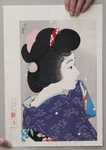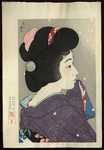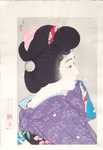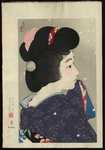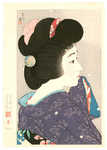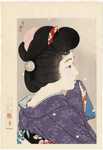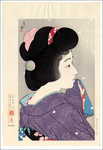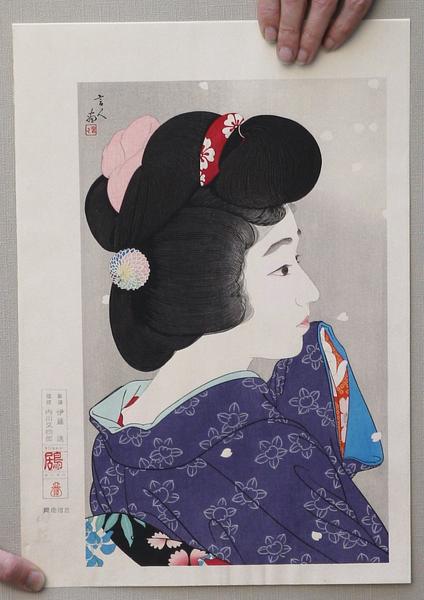| | |
| Artist: | Torii Kotondo (1900-1976) — 鳥居言人 |
| Title: | Misty Spring (Oboro Haru) — おぼろ春 |
| Series: | |
| Date of first edition?: | 1932/4 |
| Date of this artwork?: | 1980s (may not be accurate) |
| Publisher (first edition)?: | Ikeda — 池田 |
| Publisher (this edition)?: | Ishukankokai — 遺珠刊行会 |
| Medium (first edition): | Woodblock |
| Medium (this edition): | Woodblock |
| Format (first edition): | Large Oban
|
| Format (this edition): | Large Oban |
| DB artwork code: | 31046 |
| Notes (first edition)?: |
Dated April 1932 (confirmed).
Limited edition of only 100 prints, after which the blocks were destroyed.
Scene number 4 among 12 Ikeda published scenes.
Has also been called " Hazy Moon in Spring".
Re-issued in the series "Twelve Aspects of Women" circa August 23, 1988. |
|
| Notes (this edition)?: |
| The following information was taken from the original web listing of this artwork. Note that there may be some inaccuracies:
Torii Kotondo
The design is the one usually described as Oboro Haru (Misty Spring).
Please be aware that this print is not from the original edition published in the 1930's. It is from the later edition commissioned by the Torii family shortly after Kotondo's death in 1976.
As shown on the publisher's seal illustrated below, it was carved by Susumu Ito and printed by Uchikawa Matasaburo.
The print is the same size as the first edition: 40.8 x 25.6 cm (image); 47.5 x 32.5 cm (paper). So that you can easily see just how beautiful this print is, I have prepared some large 150dpi and very large 300 dpi close-up images of portions of the print:
In that image of the publisher's seal you can also see the watermark in the sheet of paper. It reads 'Sanso' …
|
|
| Artist Bio: |
| Torii Kotondo (or Torii Kiyotada VIII) is renowned for his paintings and shin hanga prints of beautiful women. His woodblock prints, superbly carved and printed, are comparable with those of Hashiguchi Goyo and Ito Shinsui. Kotondo was born with the name Saito Akira in the Nihonbashi district of Tokyo. He was the only son among the five children of Torii Kiyotada, the seventh Torii master. The Torii school had a long tradition of painting and printmaking for the Japanese theater, extending back to the seventeenth century. Kabuki theater was still very popular in the early twentieth century and prints and painted posters were the primary means of publicity. Although Kotondo was mainly interested in studying history and archaeology, it was assumed that he would follow in his father's footsteps and join the Torii school. At age 14, Kotondo agreed to leave school and begin studies with Kobori Tomone, a yamato-e painter. Along with painting classes, Tomone taught Kotondo about the court and military practices of ancient Japan, satisfying his interest in history. A year later, he was officially adopted as the next heir of the Torii school and assumed the artist's name 'Kotondo'. While still studying with Tomone, he began designing illustrations for a theatrical magazine, Engei Gaho ('Entertainment Illustrated Magazine'), and painted kabuki posters and billboards. Torii Kotondo was the 8th Torii and the 5th Torii Kiyotada. His father was the 4th Kiyotada.
|
|




